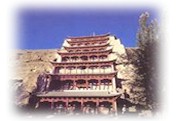| back  photo1 photo1
 photo2 photo2
 photo3 photo3
|
A city lies at the
western end of the Hexi Corridor in Gansu Province in Northwest China, an oasis on the
eastern edge of Takli- makan Desert.  It is nourished by
melted snow water from the Qilian Mountains. The ancient town used to be an important
stop-over point on the Silk Road. The name "Dunhuang" was given in the Han
Dynasty. In Chinese "Dun" means grandness and " Huang" means
prosperity. In the 2nd century B.C. Emperor Wudi of the Han Dynasty sent imperial envoy
Zhang Qian to the Western Regions, opening up a trade route which was to be known as the
"Silk Road". It is nourished by
melted snow water from the Qilian Mountains. The ancient town used to be an important
stop-over point on the Silk Road. The name "Dunhuang" was given in the Han
Dynasty. In Chinese "Dun" means grandness and " Huang" means
prosperity. In the 2nd century B.C. Emperor Wudi of the Han Dynasty sent imperial envoy
Zhang Qian to the Western Regions, opening up a trade route which was to be known as the
"Silk Road".
Dunhuang Oasisa
At the western end of the Hexi Corridor. It was the terminal of the eastern section of the
Silk Road (from Chang'an to Dunhuang) and the starting point of the middle section of the
Silk Road (from Dunhuang to Congling). An administration was set up at Dunhuang in A.D.
111. Today this tourist destination attracts people with its tourist destination attracts
people with its numerous historic sites such as Yumenguan Pass, ruins of Yangguan Pass,
Wuwa Pond, Sanwei Mountain, Ringing-Sand Hill, Crescent-Moon Pool and the many grotto
carvings and murals. The Ringing-sand Area is one of China's key tourist attractions.
(back) |